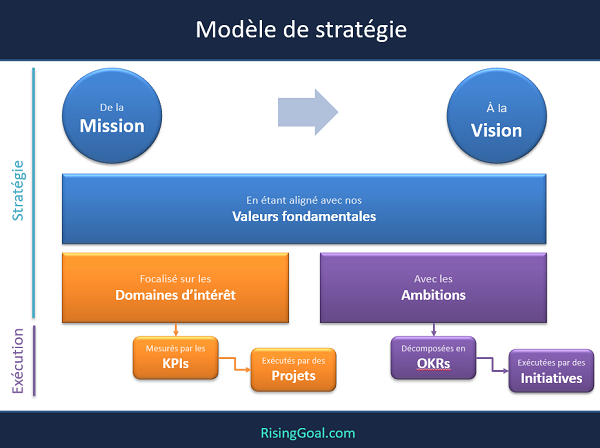OKR and KPI, an important difference
OKR and KPI are two terms commonly used to describe performance management approaches. While there are similarities between these two approaches, there are also important differences.
📈 KPIs (key performance indicators) are used to track the company’s performance in order to achieve operational excellence in its mission.
🎯 The purpose of OKRs (Objectives and Key Results) is to measure the implementation of the company’s transformation towards its strategic vision.
We will see them in detail and how these two approaches can be complementary.
Here is a diagram of Laurent Morisseau’s strategic model, to support:

Google’s example :
In 1999, Google’s OKR was:
“Organize global information and make it universally accessible and useful.” OKR that they have successfully achieved and that they are certainly following now with KPIs, it has become their Mission.
Now their announced OKR goal is:
“Making the search engine so powerful that it would include “everything in the world” is their Vision today.
KPIs, definition:

KPIs, or key performance indicators, are used to measure the company’s areas of interest, the BAU (business As Usual), which is related to its mission and raison d’être. They make it possible to monitor the health of the business and ensure that it is functioning optimally. They are often very numerous, which can lead to confusion and reduce the effectiveness of their follow-up.
Here are some examples of business KPIs:
- Retention rate
- Number of new clients acquired
- Sales cycle length or conversion time
- Conversion rate of prospects into customers
- Number of orders cancelled
OKR, definition:
OKRs, or key objectives and results, are used to measure future ambitions aligned with the company’s long-term vision. They aim to achieve a desired state that may require changes in behavior, internal processes, or external actions such as launching a new product or opening a new market. They are preferably few in number and reported by the teams themselves to promote commitment and accountability.
Here is an example of a commercial OKR:
Objective: Improve customer retention
- Key results: Increase the rate of satisfied customers by 15%
- Key results: Increase by 22% the rate of customers who recommend the company to their entourage
- Key results: Increase by 15% the rate of customers who buy again from the company
OKR, we’re aiming for impact
With OKRs, we will seek to significantly impact a strategic ambition of the company. The measurement of this impact (stretch in the Anglo-Saxon OKR literature) is specific to each corporate context and culture. It is a clever balance between audacity and realism that each team will propose.

Much more than a simple measure of performance at a given moment, a team will use OKRs to take action and achieve impactful objectives that make the difference, in alignment with the company’s strategy. To put it simply, OKRs make it possible to implement the company’s strategy at all levels.
The difference that makes the difference
We talk about OKR, but we should rather talk about “OKR working method“ (framework). Indeed, it is not enough to ask ambitious OKRs to make the difference with a KPI follow-up.
Respecting the framework will make a difference. The OKR cycle, weekly monitoring of key results, cross-team meetings, end-of-cycle review, retrospective, quarterly design workshops, etc. To go further, I refer you to Laurent Morisseau’s article: OKR cycles.
Two complementary approaches
It’s not about choosing between KPIs or OKRs. In the OKR working method, KPIs will be a complementary measure. They will monitor development hypotheses and the progress of certain key results. KPIs will also remain in parallel to measure the progress of business as usual performance.
In conclusion
It is important to understand the difference between OKR and KPI as it can impact how you design and use these performance management approaches in your organization. The OKR method aims to align the organization’s efforts towards ambitious and measurable goals, and to monitor the progress of their achievement. While KPIs are mainly used to track the organization’s performance and progress in what it has already achieved. By consistently using both approaches and integrating them into your performance management strategy, you can help your organization achieve its long-term goals.
To go further https://www.morisseauconsulting.com/2022/01/31/les-okrs-et-la-strategie/
✅ And you, are you KPI or OKR? Let us know what you think in the comments ⬇
